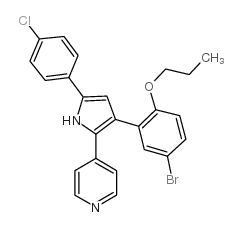191034-25-0
| Name | 4-[3-(5-bromo-2-propoxyphenyl)-5-(4-chlorophenyl)-1H-pyrrol-2-yl]pyridine |
|---|---|
| Synonyms |
Glucagon Receptor Antagonist II
Nalmefene-d3 L-168,049 |
| Description | L-168049 is a potent, selective, orally active and non-competitive glucagon receptor antagonist with IC50s of 3.7 nM, 63 nM, and 60 nM for human, murine, and canine glucagon receptors, respectively[1][2]. |
|---|---|
| Related Catalog | |
| Target |
IC50: 3.7 nM (human glucagon receptor), 63 nM (murine glucagon receptor), and 60 nM (canine glucagon receptor)[2] |
| In Vitro | L-168049 (compound 49) inhibits glucagon (100 pM) stimulated cAMP synthesis in CHO cells expressing the human glucagon receptor (hGIAR) (IC50 of 41 nM). L-168049 blocks cAMP formation stimulated by glucagon in murine liver membranes[1]. L-168049 increases the apparent EC50 for glucagon stimulation of adenylyl cyclase in Chinese hamster ovary cells expressing the human glucagon receptor and decreases the maximal glucagon stimulation observed, with a Kb of 25 nM[2]. |
| In Vivo | In the liver of L-G6pc−/- mice, Pck1 mRNA expression is decreased by half 6 h after the administration of L-168049 (50 mg/kg body; p.o.), demonstrating the efficiency of the suppression of glucagon signaling. In agreement with the role of glucagon in the induction of extrahepatic gluconeogenesis, the administration of the L-168049 prevents the increase of the G6pc expression in both the kidneys and intestine of 6 h-fasted L-G6pc−/- mice[3]. |
| References |
| Density | 1.367g/cm3 |
|---|---|
| Boiling Point | 542.3ºC at 760mmHg |
| Molecular Formula | C24H20BrClN2O |
| Molecular Weight | 467.78500 |
| Flash Point | 281.8ºC |
| Exact Mass | 466.04500 |
| PSA | 37.91000 |
| LogP | 7.61540 |
| Vapour Pressure | 2.83E-11mmHg at 25°C |
| Index of Refraction | 1.626 |
